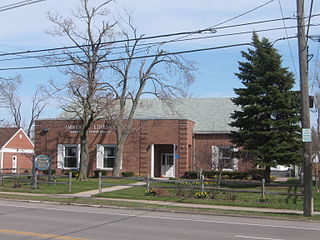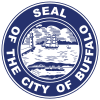
Lancaster is a village in Erie County, New York, United States. As of the 2010 census, the village population was 10,352. It is part of the Buffalo–Niagara Falls Metropolitan Statistical Area.

First Avenue is a north-south thoroughfare on the East Side of the New York City borough of Manhattan, running from Houston Street northbound to 127th Street. At 125th Street, most traffic continues onto the Willis Avenue Bridge over the Harlem River, which continues into the Bronx. South of Houston Street, the roadway continues as Allen Street south to Division Street. Traffic on First Avenue runs northbound (uptown) only.

Kensington is a neighborhood in Philadelphia, Pennsylvania, United States, which straddles Lower Northeast and North Philadelphia. It is part of the River Wards section of Philadelphia. Modern Kensington is larger than the former Kensington District, and unlike the latter, the former does not include Fishtown.
New York State Route 198 (NY 198) is a state highway located entirely within the city of Buffalo, New York, in the United States. It is named the Scajaquada Expressway for Scajaquada Creek, which it covers over as it heads across northern Buffalo. NY 198 connects the Niagara Thruway in the Black Rock neighborhood to the Kensington Expressway (NY 33) on Buffalo's east side, dividing the city's premier public park in half.
The University Heights District is a neighborhood in Buffalo, New York.
New York State Route 33 (NY 33) is an east–west state highway in western New York in the United States. The route extends for just under 70 miles (113 km) from NY 5 in Buffalo in the west to NY 31 in Rochester in the east. It is, in fact, the only state highway that directly connects both cities, although it is rarely used today for that purpose. The westernmost 10 miles (16 km) of NY 33 in Buffalo and the neighboring town of Cheektowaga have been upgraded into the Kensington Expressway. This section of NY 33 is one of several expressways leading out of downtown and serves as a main route to the Buffalo Niagara International Airport.
Vanderbilt Avenue is the name of three thoroughfares in the New York City boroughs of Brooklyn, Manhattan, and Staten Island. They were named after Cornelius Vanderbilt (1794–1877), the builder of Grand Central Terminal in Midtown Manhattan.

Riverside is a neighborhood of Buffalo, New York, located in the northwestern part of the city, along the Niagara River. It is sometimes referred to in conjunction with another community located directly south, Black Rock.

Snyder is a hamlet within the town of Amherst in Erie County, New York, United States that is part of the Buffalo – Niagara Falls metropolitan area. The hamlet was established in 1837. It was named for Michael Snyder, its first postmaster, who also operated a store at the corner of Harlem Road, which is also known as New York State Route 240, and Main Street, which is also known as New York State Route 5. The hamlet blossomed due to retail activity demand created along the Main Street transportation route between Buffalo and points to the east in the 19th and early 20th century.

International Fair Association Grounds was a fairgrounds and later a short-lived baseball and football ground located in Buffalo, New York. The ballpark, built on a portion of the former fairgrounds, was home to the Buffalo Buffeds/Blues of the Federal League in 1914 and 1915.

North Buffalo, is a neighborhood in the city of Buffalo, New York.
The Upper West Side is a neighborhood in Buffalo, New York.
The East Side is a large district of Buffalo, New York, and the city's physically largest neighborhood. It is bordered by Main Street to the north and west, I-190 and the Kaisertown neighborhood to the south, and the town of Cheektowaga to the east. Large, ornate 19th-century churches, most of them Roman Catholic, and modest 1+1⁄2-story wood-frame cottages, often with progressively smaller rear additions that give a telescoping effect, characterize the district. The East Side was once the second largest Polish-American community in the United States. Jefferson Avenue, and the intersection of Broadway and Fillmore, serve as its most heavily used commercial districts.
The Lovejoy District is a neighborhood in Buffalo, New York. Lovejoy is the easternmost portion of the city, running along the city's border with Cheektowaga. The councilman of the area in 2017 is Richard Fontana.

East High School was a comprehensive high school located in the East Side of Buffalo, New York. It operated from 1927 until 1977, reopened in 2005 and closed again in 2018 due to low academic performance. East High began phasing out in 2015 and was replaced by East Community High School and Pathways Academy, which are both housed in the building.

The Academy School 131 (also known as Alternative High School is an alternative school located in Buffalo, New York. It has gone through two separate eras, and was located at 268 Oak Street in Downtown Buffalo. The original Buffalo Alternative High School was closed in 2003 due to budget cuts, with a new alternative high school program being re-opened in Buffalo in 2006.
The Fruit Belt is a residential neighborhood in Buffalo, New York. It is located adjacent to the Buffalo Niagara Medical Campus.
Schiller Park is a neighborhood of Buffalo, New York, located in the easternmost part of the city along the Cheektowaga border.
Central Park is the name of a neighborhood in Buffalo, New York. The neighborhood known as Central Park derives from a development conceived by cement magnate Lewis Jackson Bennett (1833–1925) on his Buffalo Cement Company property. His Central Park home was designed by Buffalo architect Milton Earl Beebe.

Transportation in Buffalo, New York is dominated by automobile use, but other modes of transportation exist in the city.











